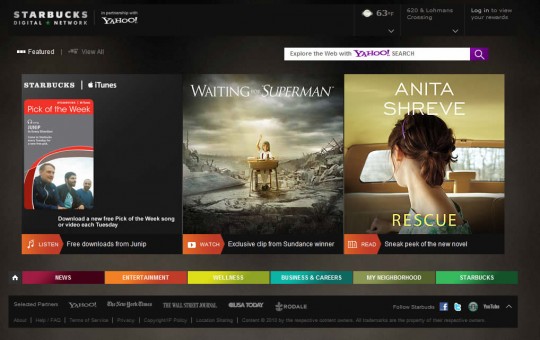Starbucks, Your Digital Neighborhood?

Starbucks has changed a lot in the last six months, at least in the digital world. First, they finally ditched their paid-only Wifi and went to a free system that requires only one-click acceptance of their terms of use. Then, a few days ago, they launched a new portal page with some of their featured music, movie, and book content front and center. They also provide Yahoo-powered news and other content reached by a small navigation bar at the bottom of the screen. (Oddly, as I was writing this inside a Starbucks, the Yahoo content was throwing errors. It refused to acknowledge that I was in a Starbucks, even though I was indeed connected to their wifi and the Internet.)
I’m still not sure I understand Starbucks continued emphasis on semi-obscure entertainment content; I suppose it is a brand positioning play. But that’s not my focus here. One item conspicuously absent from Starbucks attractive but rather sterile portal page is community.
Originally, Starbucks intended to emulate the ambiance (sort of) one might find in a European coffee shop. Great aromas, a pleasant environment, good seating that mixes both cafe tables and easy chairs, friendly baristas, and the opportunity to chat with fellow caffeine addicts. Building a micro-community seemed to be part of their plan, as most of their shops served a neighborhood. This often allowed the baristas to learn the names of regular customers, and for the customers themselves to get to know each other. This was a great concept, and one that propelled them to leadership in the coffee shop market.
Now, ten years into the 21st century, Starbucks needs to redefine community to include the digital world. People’s coffee shop behavior has changed – today, most don’t sit there and sip coffee while idly watching passers-by or even reading a newspaper. Rather, solitary patrons are likely to be using a laptop or a smartphone, even if they are just catching up on the day’s headlines. Those same patrons are likely using social media, too. This electronic focus greatly reduces the probability of casual conversation and makes community formation more difficult.
What’s the solution to declining neighborly behavior? Starbucks needs to foster digital interaction just as in the past they encouraged physical interaction. They have the ability to know who’s in their restaurant – their digitally active patrons are all connected via their hotspot. Why not let customers opt-in to identify themselves? While Starbucks could offer its own optional user authentication, better to connect with Facebook or Twitter to streamline the process and perhaps display their public activity. A Twitter timeline for logged-in guests would be simple enough to display. Maybe the guy hunched over his laptop who I assumed was working on his Great American Novel is actually tweeting about an interesting marketing topic.
Allowing a local instant message interaction between patrons would be a useful enhancement, too. Obviously, any and all interaction would have to be on an opt-in basis, as some portion of the patrons won’t want to be bothered.
I tend to spend at least an hour per day working from a coffee shop like Panera, Starbucks, or an independent in part for the exposure to people that I don’t get in my home office. I’m typically actually working, so I’m not likely to lean back in an easy chair and strike up a full-blown conversation. Nevertheless, it’s nice to say hello to familiar faces and exchange a word or two.
I’d guess that the environment and interaction is what brings many people to Starbucks and other coffee shops. No doubt, these customers have coffee (perhaps even better) and Internet (faster and more secure) at their home and/or office.
So why not foster stronger community at the individual shop level? Doing so would build store traffic and increase loyalty. I’ve got a dozen coffee shop/restaurant hot spots within ten minutes, and I tend to rotate among some of them for a change of scenery. If I knew I’d be among people I knew at one of them, though, I’d probably give that location the lion’s share of my business.
Digital community is no panacea, of course. Much of the business at a Starbucks is carry-out. Harried commuters run in, grab their java, and go. Still, I think Starbucks could fill more of its tables by bringing its “neighborhood café” concept into the digital age.
How would you react if Starbucks suggested you log in, say, with Twitter? Too much bother? Yet another assault on privacy? Or a fun way to connect with those around you?
